Situated in the pedestrianised part of West Street, The Crown Inn was first recorded in 1841 as The Crown Brewery and was then the nearest inn to the old market site. From around 1870 to the early 1900s, The Crown Brewery was run by the Cawte brothers. In the 1911 trade directory for Fareham, the premises were listed as The Crown Inn. The licensee was Mrs Clara Frost, who remained in charge for nearly 20 years.
Photographs and text about The Crown Inn.
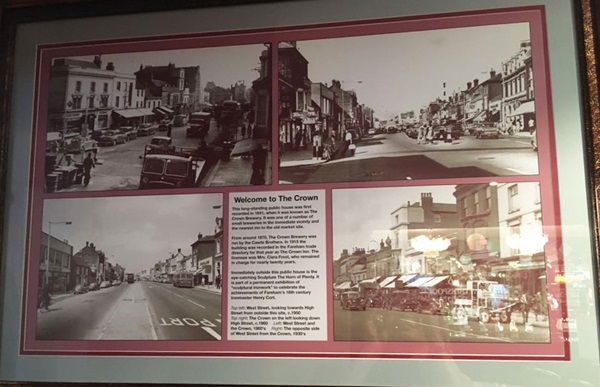
The text reads: This long standing public house was first recorded in 1841, when it was known as The Crown Brewery. It was one of a number of small breweries in the immediate vicinity and the nearest inn to the old market site.
From around 1870, The Crown Brewery was run by the Cawte Brothers. In 1915 the building was recorded in the Fareham trade directory for that year as The Crown Inn. The licensee was Mrs Clara Frost, who remained in charge for nearly twenty years.
Immediately outside this public house is the eye-catching sculpture The Horn of Plenty. It is part of a permanent exhibition of sculptural ironwork to celebrate the achievements of Fareham’s 18th century ironmaster Henry Cort.
Top left: West Street, looking towards High Street from outside this site, c1950
Top right: The Crown on the left looking down High Street, 1960
Left: West Street and The Crown, 1960s
Right: The opposite side of West Street from The Crown, 1930s.
Illustrations and text about Fareham changing through the times.
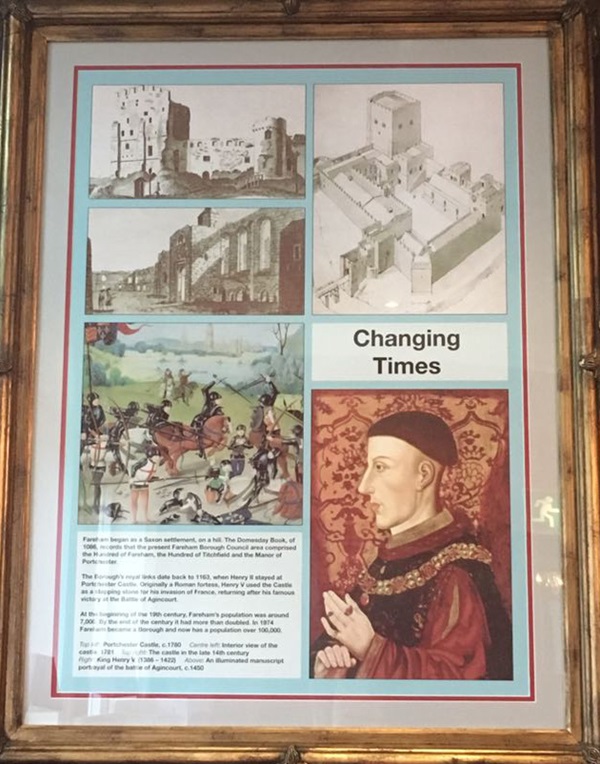
The text reads: Fareham began as a Saxon settlement, on a hill. The Domesday Book, of 1086, records that the present Fareham Borough Council area comprised the Hundred of Fareham, the Hundred of Titchfield and the Manor of Portchester.
The borough’s royal links date back to 1163, when Henry II stayed at Portchester Castle. Originally a Roman fortress, Henry V used the castle as a stepping stone for his invasion of France, returning after his famous victory at the Battle of Agincourt.
At the beginning of the 19th century, Fareham’s population was around 7,000. By the end of the century it had more than doubled. In 1974 Fareham became a borough and now has a population over 100,000.
Top left: Portchester Castle, c1780
Centre left: Interior view of the castle, 1781
Top right: The castle in the late 14th century
Right: King Henry V, (1386–1422)
Above: An illuminated manuscript portrayal of the battle of Agincourt, c1450.
Illustrations and text about Cams Hall.
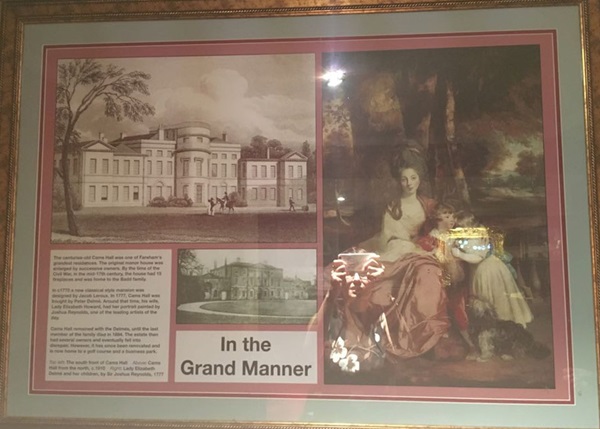
The text reads: The centuries old Cams Hall was one of Fareham’s grandest residences. The original manor house was enlarged by successive owners. By the time of the Civil War, in the mid 17th century, the house had 15 fireplaces and was home to the Badd family.
In c1770 a new classical style mansion was designed by Jacob Leroux. In 1777, Cams Hall was bought by Peter Delme. Around that time, his wife Lady Elizabeth Howard, had her portrait painted by Joshua Reynolds, one of the leading artists of the day.
Cams Hall remained with the Delmes, until the last member of the family died in 1894. The estate then had several owners and eventually fell into disrepair. However, it has since been renovated and is now home to a golf course and a business park.
Top left: The south front of Cams Hall
Above: Cams Hall from the north, c1910
Right: Lady Elizabeth Delme and her children, by Sir Joshua Reynolds, 1777.
Photographs and text about Lord Arthur Lee.
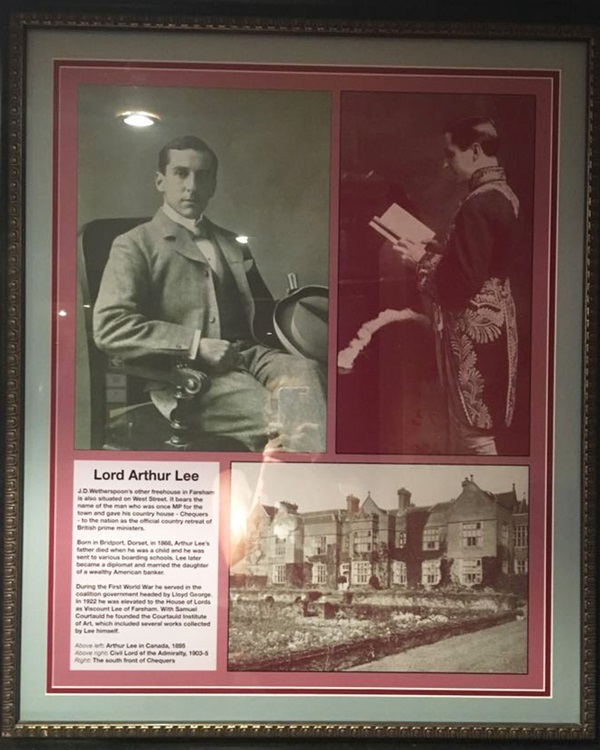
The text reads: J D Wetherspoon’s other freehouse in Fareham is also situated on West Street. It bears the name of the man who was once MP for the town and gave his country house – Chequers – to the nation as the official country retreat of British prime ministers.
Born in Bridport, Dorset, in 1868, Arthur Lee’s father died when he was a child and he was sent to various boarding schools. Lee later became a diplomat and married the daughter of a wealthy American banker.
During the First World War he served in the coalition government headed by Lloyd George. In 1922 he was elevated to the House of Lords at Viscount Lee of Fareham. With Samuel Courtauld he founded the Courtauld Institute of Art, which included several works collected by Lee himself.
Above left: Arthur Lee in Canada, 1895
Above right: Civil Lord of the Admiralty, 1903-5
Right: The south front of Chequers.
Illustrations and text about Henry Cort.
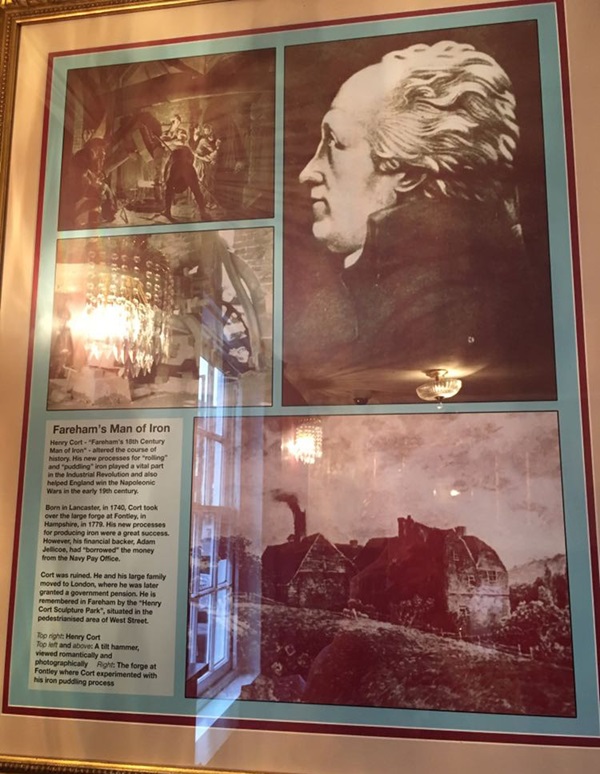
The text reads: Henry Cort – ‘Fareham’s 18th century Man of Iron’ – altered the course of history. His new processes for rolling and puddling iron played a vital part in the Industrial Revolution and also helped England win the Napoleonic Wars in the early 19th century.
Born in Lancaster, in 1740, Cort took over the large forge at Fontley, in Hampshire, in 1779. His new processes for producing iron were a great success. However, his financial backer, Adam Jelliecoe, had borrowed the money from the Navy Pay Office.
Cort was ruined. He and his large family moved to London, where he was later granted a government pension. He is remembered in Fareham by the Henry Cort Sculpture Park, situated in the pedestrianised area of West Street.
Top right: Henry Cort
Top left and above: A tilt hammer, viewed romantically and photographically
Right: The forge at Fontley where Cort experimented with his iron puddling process.
Illustrations and text about Titchfield.
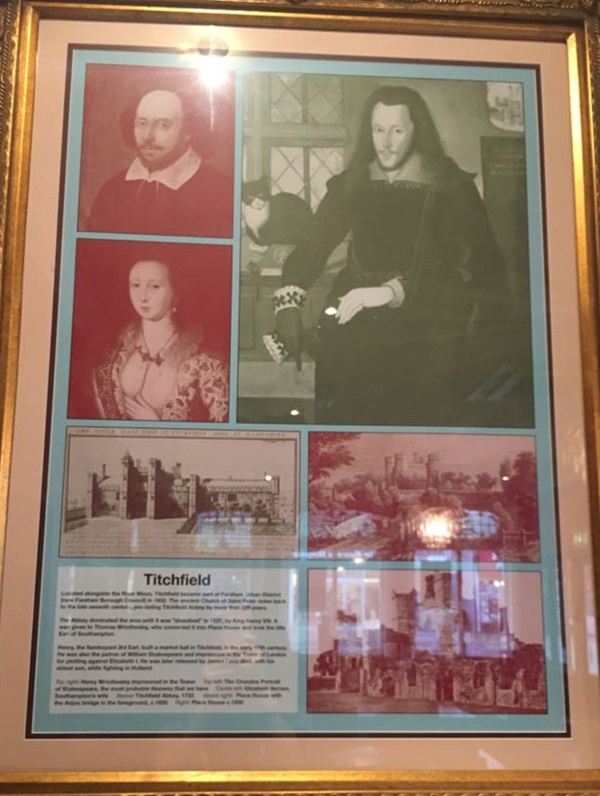
The text reads: Located alongside the River Meon, Titchfield became part of Fareham Urban District (now Fareham Borough Council) in 1932. The ancient Church of Saint Peter dates back to the late seventh century, pre-dating Titchfield Abbey by more than 500 years.
The abbey dominated the area until it was dissolved in 1537, by King Henry VIII. It was given to Thomas Wriothesley, who converted it into Place House and took the title Earl of Southampton.
Henry, the flamboyant 3rd Earl, built a market hall in Titchfield, in the early 17th century. He was also the patron of William Shakespeare and imprisoned in the Tower of London for plotting against Elizabeth I. he was later released by James I and died, with his eldest son, while fighting in Holland.
Top right: Henry Wriothesley imprisoned in the tower
Top left: The Chandos Portrait of Shakespeare, the most probable likeness that we have
Centre left: Elizabeth Vernon, Southampton’s wife Above: Titchfield Abbey, 1733
Above right: Place House with the Anjou Bridge in the foreground, c1820
Right: Place House, c1950.
Illustrations and text about William Makepeace Thackeray.
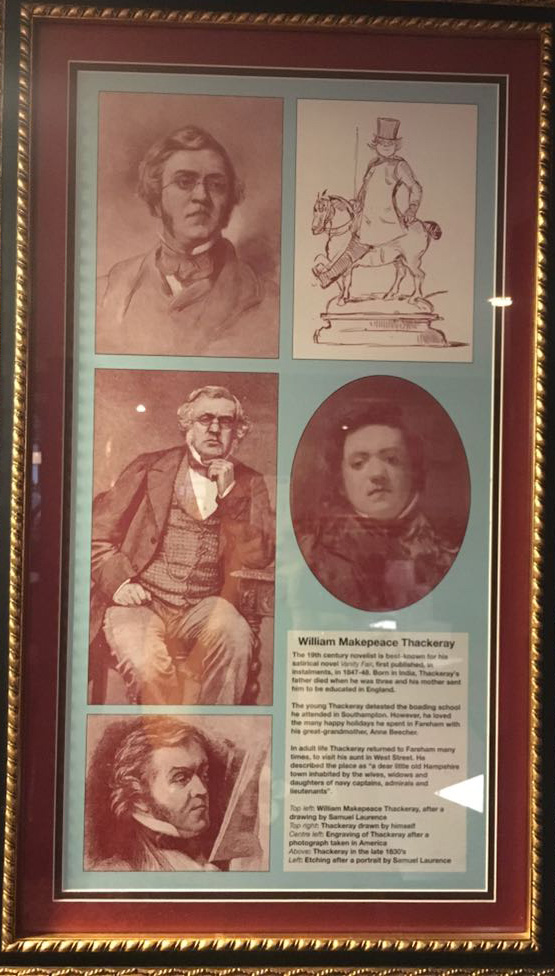
The text reads: The 19th century novelist is best known for his satirical novel Vanity Fair, first published, in instalments, in 1947-48. Born in India, Thackeray’s father died when he was three and his mother sent him to be educated in England.
The young Thackeray detested the boarding school he attended in Southampton. However, he loved the many happy holidays he spent in Fareham with his great-grandmother, Anne Beecher.
In adult life Thackeray returned to Fareham many times, to visit his aunt in West Street. He described the place as “a dear little old Hampshire town inhabited by the wives, widows and daughters of navy captains, admirals and lieutenants”.
Top left: William Makepeace Thackeray, after a drawing by Samuel Laurence
Top right: Thackeray drawn by himself
Centre left: Engraving of Thackeray after a photograph taken in America
Above: Thackeray in the late 1830s
Left: Etching after a portrait by Samuel Laurence.
A photograph of West Street, c1905, looking towards the junction with High Street and East Street.
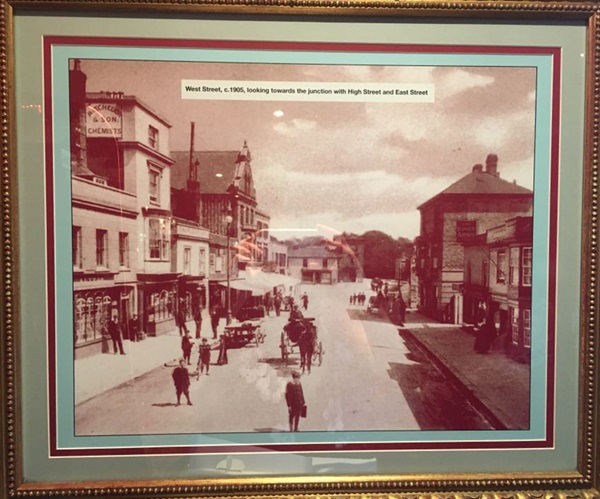
An acrylic painting entitled Abbey Storm Clouds, by Olivia Nurrish.
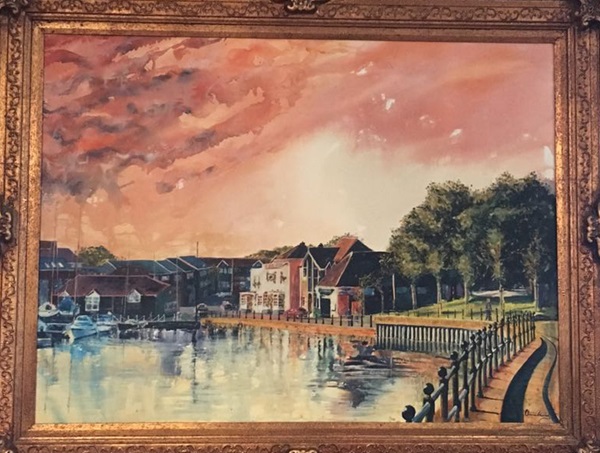
An acrylic painting entitled Quay at Dusk, by Olivia Nurrish.
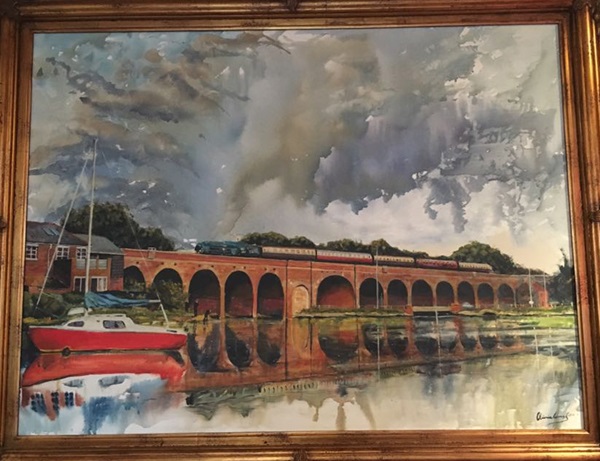
External photograph of the building – main entrance.
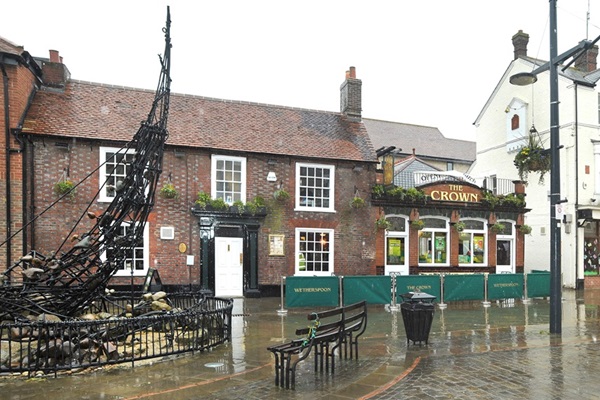
If you have information on the history of this pub, then we’d like you to share it with us. Please e-mail all information to: pubhistories@jdwetherspoon.co.uk